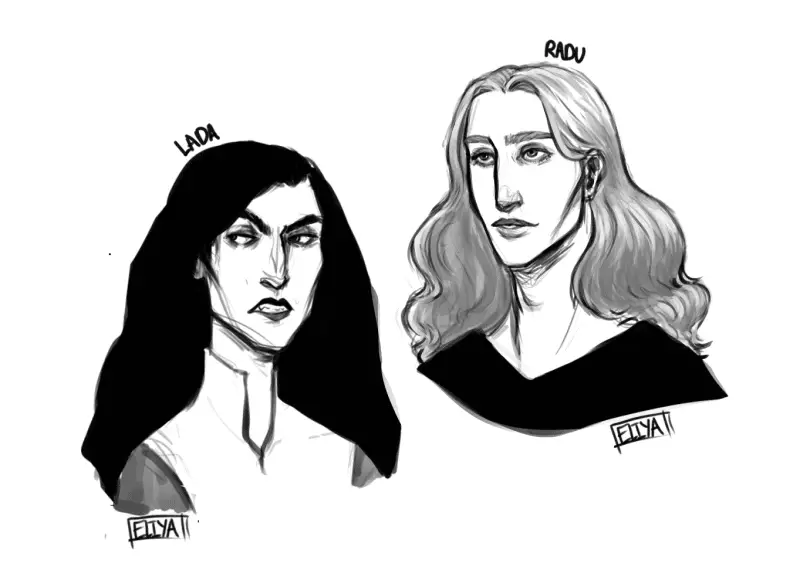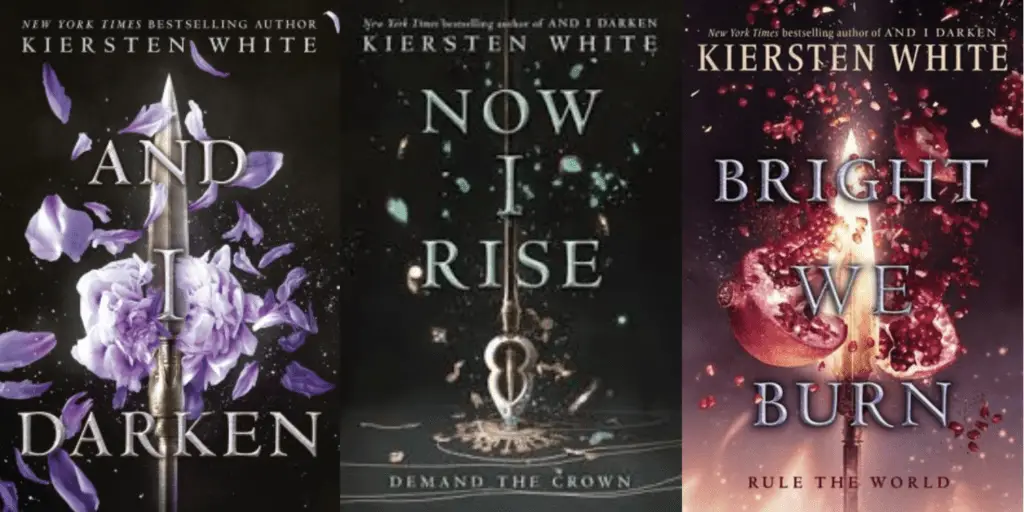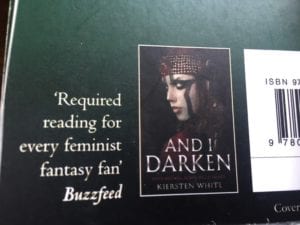The Conqueror’s Saga, now composed of three volumes, is a young adult novel series by Kiersten White. I thought for quite some time about the genre of story it was. It is not fantasy, but it isn’t historical either. I eventually had to settle for “alternate history,” which isn’t something I am used to seeing in YA.
The premise of The Conqueror’s Saga is ‘What if Dracula was born a girl?’. And when I say Dracula, I mean the historical Vlad III Basarab warlord of Wallachia in the 15th century. The man Bram Stocker allegedly based the literary Dracula on. That Bram Stocker actually knew about Vlad III or not is of little matter for people studying the historiography around him. Vlad III and Dracula are inter-connected for good now. That might be because Vlad III suffers from a disastrous reputation (even if in Romania a counter historiography hailing him as a national liberator has existed since the 19th century). His nickname is Vlad Tepes, the impaler. And as my professor of history of the Ottoman Empire once said, ‘A prince worthy of the title DOES NOT impale people’.
For length reasons and because I am not an expert, we will stop here with the historiography around Vlad Tepes. Let’s just said that Vlad Tepes was a Wallachian prince who fought against Ottoman rule and had a talent, maybe even a taste, for extreme violence. So what if Vlad was born Ladislav (‘Lada’ for friends and family)? Well, you get an interesting ambitious YA series.
Also disclaimer before going further: I am by no mean an expert in Ottoman History. I am an enthusiast who has taken a class about it and written several university papers on it. Sure, that probably makes me more knowledgeable about the Ottoman Empire than the average European, but I won’t be giving any lessons on it. Especially not to an author who probably did her fair share of research. I will talk about some aspects of the representation of the Ottoman Empire in the books, but I know the historiography around is complex. It has been vilified or at best turned into an exotic land of wonder by European historiography. So if I ends up making a mistake or a wrong assumption I apologize in advance. Don’t hesitate to correct me.
Now let’s dive in.
Lada and Radu as the heart of the story
The Conqueror’s Saga focuses mainly on Lada and Radu. Radu is Lada’s little brother, also based on a historical figure, Radu III the Fair, younger brother of Vlad Tepes and reputed lover of Mehmet the Conqueror. Their point of views alternate from one chapter to another.

Lana and Radu are interesting protagonists, because they are complex human beings of course. But also because they don’t fit in. Lada is an ugly, physically capable, strategic, immensely proud girl (considering that she must be 18 or barely more by the end of the second book, I will keep using girl or young woman for Lada). Radu, on the contrary, is a pretty, even beautiful, delicate, deeply empathetic, sociable, eager-to-please boy. Oh, and he is gay too.
They were born to a violent, cowardly, eager-to-be-honored man. Their mother was too young to resist the life with their piece of shit of father, so they ended up stuck between an impotent, violent man and their nurse. Oh and yes this is still the 15th century in Eastern Europe. You smell a recipe for disaster? You aren’t wrong.
Lada grows up to be a violent, angry young woman and Radu a shy young man who pathologically wants to be loved by the wrong people. And of course when they are given as hostages to the Ottoman Court in Edirne, they are absolutely unequipped to survive here. And they suffer a lot. That is before meeting Mehmet. Their meeting with the future Sultan makes them bloom.
It allows Lada and Radu to develop their talents. Lada becomes a good strategist and an excellent leader of men (especially of men of lowly birth). Radu becomes an excellent courtier and a prolific liar with a great political mind. However, they still have the shortcomings seen earlier. Because 4-5 years of relative happiness don’t suppress a decade of abuse. Also they both fall in love with Mehmet.
Lada and Radu are deeply flawed human beings, and this is one of my favorite thing in The Conqueror’s Saga. Yes they are talented, they are clever, they have a goal, but they aren’t perfect. They lie to themselves, they are hypocrites. And even when Lada promises herself to be hard, she still has compassion for poor and defenseless people. The majority of the characters manage a certain level of complexity that make them more than archetypical supporting characters.
I love reading about human beings. And this what White manages to do. She creates a world full of human beings with their moments of greatness, their lies, and their cowardliness. It is great to read a YA series of novel with such characters.
Political intrigues, dubious morality, and battles
For a YA series, The Conqueror’s Saga doesn’t shy away from complexity. The historical context, while simplified, isn’t reduced to bad guys vs good guys. The Ottoman Empire is more sophisticated, more interested in its smooth running and in its development than any other political entity. Yet they are also sophisticated in their cruelty, ruthlessness, and readiness to destroy whatever or whoever stands in their way.
Walachia, while not being the people crushing machine that the Ottoman court is, has zero to little consideration for its people. The local nobles even take a vicious pleasure in abusing them. Constantinople is a decadent city. Not in the morally corrupt sense, rather Constantinople is well past its glory days and doesn’t know how to change in order to survive and doesn’t want to.
All in all, we have three very different settings with their grandeur and their misery. Considering that our two main characters have deeply political storylines, these settings are of high importance. Lada wants to become the Prince of Walachia in her own right. Radu wants to please Mehmet and bring him to new heights. Where White excels is the political intrigue and the backstage action. As a result, every character dealing and booming in political intrigue are especially well written. Radu’s chapters are always interesting, and I love secondary characters such as Huma and Nazira. Even if for the latter I wonder if White notices the actual mental gymnastic needed to morally justify her actions in Constantinople.

Another thing that White does particularly well is the description of the psyche of her characters. Considering the setting and the goals of our characters, they end up making decisions that are morally bankrupt. Here lies the risk of disconnecting from the characters, since we do not share their basis for morality, education, and cultural context. And yet, White manages to make the reader think, “Sure she killed them all without leaving them any possibility to defend themselves… But wouldn’t you have done it too?”. And the answer is yes. Yes, I would have done it too. God damn it.
White seems anxious to do the context justice. Indeed, in the author’s note to And I Darken, she states:
“The characters in the series each interact with religion, and more specifically Islam, in various ways. I have nothing but respect for the rich history and beautiful legacy of that gospel of peace.”
She is after all dealing with an historical subject and with two cultures that aren’t hers. I must say that she has done a good job, especially with Islam. She presents two characters, Radu and Kumal, whose faith is a constant support and turns them into better people because of it.
However, I must confess that as I haven’t read the third volume yet, she hasn’t done the same justice to Orthodox Christianity. Here the lack of significant characters for whom their Orthodox Christian faith is an important, positive force in their life is detrimental. In the end, Orthodox Christianity appears as cold and remote from the people. It could be White’s actual view on Christianity (and everyone is entitle to their view on religion, I certainly have my owns), but I somehow doubt it’s the case. It’s just that the portrayal of the Orthodox Christian faith didn’t get the same nuance and attention Islam had. And that’s a shame.
Finally, another thing that isn’t as good as I expected is White’s descriptions of battles and action scenes. Not that they are bad, far from it. Not only are her fights realistic, they are also clever (Lada’s tendency to bite people since childhood? Brilliant!). Nevertheless, you can feel that White is more at ease in the political backstabbing arena. Several times, we are left with a point a view remote from the battle or in a more strategic part of it. What can I say, much like Lada, I love being in the middle of the battle (at least when I am reading).
That being said, we have not advanced very far on the theme of this article have we? I told you why I think The Conqueror’s Saga is a good series of YA novels, but I haven’t really dove into feminism yet. Let’s go there now.
Feminism?
I am not entirely comfortable talking about the feminist value of a series of novels mainly written for entertainment purposes. Before everything, I enjoyed The Conqueror’s Saga as a well written, thrilling, character driven conquest story. But as an infamous predecessor once did, The Conqueror’s Saga didn’t give me a lot of choice when it came to considering its feminism.

And there is this, too, in the Acknowledgments of the second volume:
“Finally, I feared people wouldn’t connect with my brutal, vicious Lada and my tender, clever Radu. […] To everyone who embraced the Dracul siblings and these books: thank you, thank you, thank you. A girl could take over the world with you on her side.”
So how does it holds up? Is it really ‘required reading for every feminist fantasy fan’? No. Mainly because it’s not fantasy, it’s alternative history. At least if no major changes have been introduced in the third volume.
I have to concede that when someone is trying to force my hand so much in a direction I really want to go in the exact opposite direction (I would have made a poor horse). Third, there is the all ‘giving the accomplishment of historical men to women to make them look good’, which isn’t the epitome of feminism.
There is also the fact that it isn’t the first time I’ve crossed paths with brutal, vicious female characters that I end up loving madly. Kriss de Valnor from the French graphic novel series Thorgal. Mitsuko Soma from Battle Royale (the book) etc etc.
And yet… There is something deeply important in The Conqueror’s Saga with Lada. While writing this article I thought of several things. The first one is the current trend of criticizing Strong Female Characters™ in YA. There is a tad of truth in the often used argument that a lot of those characters are just men in disguise and that those storylines are an attack on women. I would say that this is an incomplete argument that refuses to acknowledge that the issue here is not with women but with femininity.
Sometimes, stories with Strong Female Characters™ are a poorly articulated attack on femininity because they are not very good books. In such examples, we are faced with a Not Like Other Girls™ type of protagonists rather than a complex human character. But sometimes, it is the person doing the critique who hasn’t realize that they haven’t understand the story of the character at all… cough cough cough Furiosa. But let me tell you something, as a woman who used to be a tomboy, as a graduate student in social sciences, as someone who wrote the majority of her papers on the position of women in society: you are god damn right to be wary and resentful of ‘femininity’.
Not because needlework is useless (it’s not). Not because being nice and pleasant is a bad thing (society would be a better place if more people were like that). But because ‘femininity’ exists as the epitome of what is expected of a woman in the gendered division of labor. In a patriarchal society, this gendered division of labor limits the power and independence of women as individuals. Where dozens of youtubers and YA writers fail to see why some people might have issues with ‘femininity’ considered in a patriarchal context, White hits the nail on the head.
By presenting a diversity of female characters on a large spectrum from traditionally feminine to absolutely not feminine, White reminds us that no matter what kind of woman you are, you will face hardships. And there are no good or bad ways to face them. At the end of the day, the women of The Conqueror’s Saga face the same issues. They are not free. They are robbed of their agency. They are not considered, because they are women and they fight the best they can against this. Sometimes they triumph, sometimes they fail. But they all have their strengths, weaknesses, braveries, and cowardlinesses.
Lada’s anger… Let me talk about anger. More precisely about women’s anger. When I was a young teenager, I read Battle Royale by Koshun Takami. For those of you who don’t know what it is, Battle Royale is a dystopia in which Japan is a dictatorship that sends a class of 14 years old on an island to fight to the death every year. In the book, you follow one of these classes. Contrary to Hunger Games, all participants know each other and you follow different point of views. I still remember vividly one of the chapters.
It is from the point of view a girl that is a top student, good in her class, and a competent athlete. She runs into one of her classmates, a really popular boy and excellent football player. She has always been uneasy about him because she feels like she has been pressured to date him. Despite the fact that she didn’t want it, he did nothing on his side to stop this. They have a chat (hey, they are still classmates) in which he confesses that he would have liked to date her but considering the circumstances, he is going to rape and kill her instead.
She passes through a turmoil of emotion, horror, fear. But eventually she fixes on anger. Anger at this boy in front of her, anger for the insignificance of her life no matter how good she is, anger for the violence surrounding sexuality. An anger so burning and so consuming that she ends up killing him.

Sure, this girl doesn’t survive her one and only chapter (she is killed by the other angry girl of the book—Mitsuko Soma) but it left an impact on me. It taught me that I could be angry. That I was not wrong because I was angry. Lada has this kind of all-consuming anger. And it comes mainly from how she is treated because she is a girl. I think it is important that young girls fall on this sort of feminine anger by chance in one of their readings. The Conqueror’s Saga might be this reading for some of them.
So yes, I think Kriesten White’s Conqueror’s Saga deals with feminist themes and does it properly.
Conclusion
If you have been tempted by the synopsis of And I Darken and that you wouldn’t resent being taken away from the bulk of the action to focus on strategy and political intrigue you will enjoy The Conqueror’s Saga. You will enjoy it because it is well written, with interesting characters. Also because it is dark and twisted. But most importantly the Conqueror’s Saga stands out because the author has done her homework. She has not only been able to create a complex setting but she knows how to make her characters interact with it. Especially her female characters.
Ugly, violent, ambitious Lada might be the kind of person girls and young women need to spend more time with to understand that no matter who they are they should be valued.

